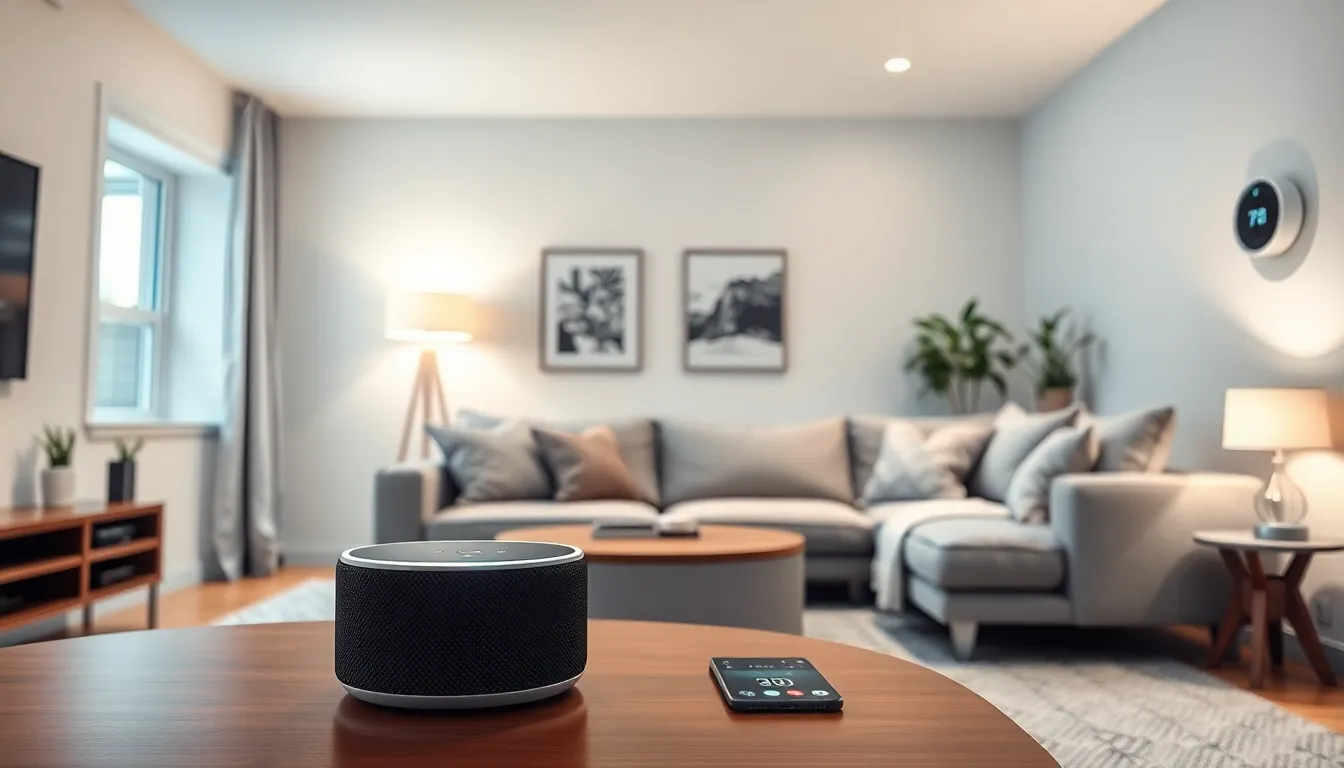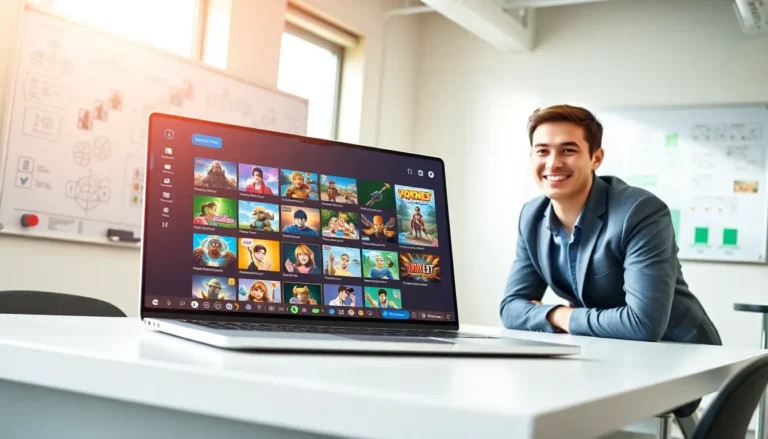Table of Contents
ToggleIn a world where your toaster might just be smarter than your high school math teacher, connected technology is redefining what it means to be “plugged in.” Imagine a morning where your coffee brews itself while your fridge gently reminds you that it’s time to restock on pickles. It’s not just a futuristic dream; it’s the reality of our hyper-connected lives.
Overview of Connected Technology
Connected technology refers to the integration of devices, systems, and networks that communicate and share data. This technology enables enhanced automation and improved user experiences across various environments, including homes, workplaces, and cities.
Definition of Connected Technology
Connected technology encompasses smart devices and applications that rely on the internet to function. These devices include smart home gadgets, wearables, and connected appliances. Each device connects with others, enabling real-time data exchange. Through this interconnectedness, users can remotely control devices, receive notifications, and automate daily tasks, enhancing their overall efficiency.
Importance in Today’s World
Connected technology plays a crucial role in modern society. It streamlines processes and conserves resources, significantly impacting how individuals live and interact. A 2023 study revealed that over 60% of households utilize smart devices for everyday tasks. In workplaces, connected technology boosts productivity by automating time-consuming functions. This trend fosters innovation, improves security, and creates smarter environments. Embracing connected technology ensures that society adapts to evolving demands and lifestyles.
Applications of Connected Technology

Connected technology enhances everyday experiences across various sectors. Key applications include smart homes and wearable devices, both of which improve convenience and efficiency.
Smart Homes
Smart homes utilize connected devices to streamline daily routines. Home automation systems control lighting, heating, and security through smartphones or voice commands. A recent report indicates that over 60% of households engage with smart devices for tasks like adjusting thermostats or managing home security. Devices such as smart refrigerators keep track of inventory and suggest recipes based on available items. Furthermore, energy management platforms enable users to reduce their energy consumption, promoting sustainability. The convenience of operating everything remotely makes smart homes a popular choice for modern living.
Wearable Devices
Wearable devices have revolutionized personal health management. Smartwatches and fitness trackers monitor physical activity, heart rate, and sleep patterns. Statistics show that these devices provide valuable insights, improving users’ health and fitness levels. Notifications from apps facilitate communication without needing to check phones constantly. Medical wearables also play a crucial role in monitoring chronic conditions. For instance, devices can track blood glucose levels or heart rhythms, alerting users and healthcare professionals to irregularities. Overall, wearables offer a comprehensive approach to personal wellness through connected technology.
Benefits of Connected Technology
Connected technology enhances daily living through its various applications, bringing substantial advantages to users.
Enhanced Convenience
Connected technology simplifies everyday tasks. Smart home systems allow users to control appliances, lighting, and security from their smartphones or through voice commands. A recent study shows that over 60% of households use smart devices for chores such as adjusting temperatures or managing security systems. Smart refrigerators track inventory and suggest meals, saving time. Users can manage household tasks remotely, making life easier and more organized. Automated systems adapt to user preferences, improving overall comfort. Accessibility increases for people with disabilities, empowering them to control environments independently. Ultimately, connected technology fosters a lifestyle where convenience is paramount.
Improved Efficiency
Efficiency improves significantly with connected technology. Automation of routine activities saves time and reduces manual effort. In workplaces, connected devices streamline operations, as shown in a study where productivity increased due to automated functions. Smart thermostats ensure optimal energy use by learning user patterns, contributing to cost savings. Remote monitoring of devices enables proactive maintenance, preventing costly repairs. Data analytics provide insights, informing users on how to conserve resources effectively. Overall, this technology minimizes waste and maximizes productivity, creating a smarter and more efficient environment for everyone.
Challenges of Connected Technology
Connected technology presents several challenges, particularly regarding security and privacy, which require careful attention.
Security Concerns
Security concerns significantly impact the adoption of connected technology. Data breaches pose substantial risks, with cybercriminals targeting vulnerabilities in smart devices. According to a 2023 study, over 40% of organizations reported an increase in cyberattacks due to connected devices. Additionally, unauthorized access to systems can lead to potential control of home or workplace appliances, compromising safety. Experts recommend implementing strong authentication methods and regular software updates to mitigate these vulnerabilities. Manufacturers must prioritize robust security measures to ensure consumer trust in connected technology.
Privacy Issues
Privacy issues represent another critical challenge connected technology faces. The collection of vast amounts of user data raises concerns about unauthorized sharing and misuse. A survey indicated that 67% of individuals worry about personal information being exposed through connected devices. Transparency in data usage can enhance user confidence, yet many companies fail to disclose how data is handled. Data encryption and strict privacy policies can protect users, but these measures aren’t uniformly applied across all devices. Ensuring compliance with data protection regulations remains vital for the industry to foster user trust and promote safe usage of connected technology.
Future Trends in Connected Technology
Connected technology continues to evolve, driving new innovations and shaping future landscapes. Anticipated advancements focus on enhancing user experiences and increasing automation.
Emerging Innovations
Innovations in connected technology include artificial intelligence integration, which allows for smarter decision-making among devices. Voice recognition technology enhances interaction, enabling hands-free control. The rise of edge computing reduces latency by processing data closer to the source, improving response times for critical applications. Real-time analytics enable predictive maintenance in connected devices, minimizing downtime and extending equipment lifespan. Companies increasingly invest in interoperability, ensuring devices from various manufacturers communicate seamlessly, fostering a more cohesive connected environment.
Predictions for Growth
Growth projections for connected technology indicate a remarkable increase in market size. The global connected devices market is expected to reach approximately $1 trillion by 2025. More than 75 billion connected devices will populate homes, workplaces, and cities. Developing regions will experience accelerated adoption, driven by improving internet access and smartphone penetration. Innovations in 5G technology will support faster data transmission, facilitating real-time communication between devices. Increasing awareness of sustainability will propel demand for energy management systems, pushing the technology’s growth even further.
Connected technology is reshaping lives in profound ways. As smart devices become increasingly integrated into daily routines they offer unparalleled convenience and efficiency. The ability to automate tasks and manage environments remotely enhances comfort and accessibility for everyone.
While the benefits are clear the challenges around security and privacy cannot be overlooked. Addressing these concerns is vital for fostering trust and ensuring widespread adoption.
Looking ahead the future of connected technology promises even greater advancements. With innovations on the horizon users can expect smarter devices that not only simplify tasks but also contribute to sustainability efforts. Embracing these changes will be essential as society continues to evolve in this hyper-connected landscape.





